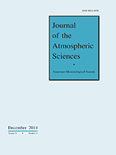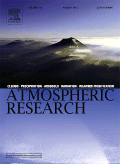
TERRESTRIAL ATMOSPHERIC AND OCEANIC SCIENCES
Scope & Guideline
Innovating Research for a Sustainable Planet
Introduction
Aims and Scopes
- Atmospheric Sciences:
Research on atmospheric phenomena, including weather patterns, climate dynamics, and air quality assessments, with a focus on understanding their impacts on terrestrial environments. - Oceanography:
Studies related to ocean processes, including ocean circulation, marine ecosystems, and the interaction between oceanic and atmospheric systems. - Seismology and Geophysics:
Investigations into seismic events, fault systems, and geophysical phenomena, providing insights into earthquake mechanisms and risks, particularly in seismically active regions. - Remote Sensing and Modeling:
Utilization of remote sensing technologies and modeling approaches to analyze environmental data, monitor changes in land and sea surfaces, and predict natural disasters. - Climate Change Impact Studies:
Research assessing the effects of climate change on hydrological cycles, weather extremes, and ecosystem responses, aiming to inform mitigation and adaptation strategies. - Technological Innovations in Environmental Monitoring:
Development and application of advanced technologies (e.g., machine learning, drones, satellite systems) for environmental monitoring and data collection.
Trending and Emerging
- Integrated Disaster Risk Management:
An increasing number of studies focus on integrated approaches to disaster risk management, particularly in the context of climate change and natural hazards, emphasizing resilience and preparedness. - Machine Learning Applications in Environmental Science:
The application of machine learning techniques for analyzing environmental data and predicting phenomena such as weather patterns and seismic activities is on the rise, showcasing the journal's embrace of innovative methodologies. - Climate Change Adaptation Strategies:
Research exploring adaptive strategies to cope with the impacts of climate change, including urban planning, resource management, and ecosystem restoration, is gaining prominence. - Urban Climate Studies:
A growing interest in the interaction between urban environments and climate dynamics, including heat islands and air quality, reflects the need for sustainable urban development. - Ocean-Atmosphere Interactions:
Increased focus on understanding the complex interactions between oceanic and atmospheric systems, particularly in relation to climate variability and extreme weather events.
Declining or Waning
- Traditional Geological Studies:
Research focusing solely on classical geological formations and fossil records has become less prominent, as the journal shifts towards more dynamic environmental processes and real-time monitoring. - Static Climate Models:
The reliance on traditional static climate models is waning, with a movement towards more integrated, dynamic models that account for complex interactions among atmospheric, oceanic, and terrestrial systems. - Historical Climate Reconstructions:
While still important, the emphasis on detailed historical climate reconstructions is declining in favor of studies that apply real-time data and predictive modeling to address current climate issues. - Localized Environmental Studies:
Research with a narrow geographic focus is decreasing, as there is a growing trend towards studies that consider broader regional or global impacts and interactions. - Purely Theoretical Research:
The publication of purely theoretical studies without empirical validation or practical application is becoming less common, as there is a stronger emphasis on applied research that can inform policy and practice.
Similar Journals

JOURNAL OF THE ATMOSPHERIC SCIENCES
Advancing the Frontiers of Atmospheric ResearchJOURNAL OF THE ATMOSPHERIC SCIENCES, published by the American Meteorological Society, stands as a premier resource for the latest research in atmospheric sciences. With an impressive impact factor and a Q1 ranking in the Atmospheric Science category for 2023, this journal is recognized for its rigorous peer-reviewed articles that contribute to the understanding and advancement of weather, climate, and dynamics of the atmosphere. Established in 1969, the journal has maintained high academic standards and delivers valuable insights spanning over five decades, thus catering to an audience of researchers, professionals, and students alike. Although it does not offer open-access options, it provides critical access through various institutional subscriptions, ensuring that significant research findings are disseminated widely within the scientific community. The journal's address is located at 45 Beacon St, Boston, MA 02108-3693, United States, and it accepts submissions and articles until 2024, continuing its legacy of excellence in atmospheric research.

Journal of Southern Hemisphere Earth Systems Science
Unveiling Insights into Southern Hemisphere Environmental Dynamics.The Journal of Southern Hemisphere Earth Systems Science, published by CSIRO PUBLISHING, stands as a pivotal resource for researchers and professionals in the fields of Atmospheric Science, Global and Planetary Change, and Oceanography. Established in 2016 and operating under an Open Access model since 2019, this journal provides a platform for innovative research and critical discourse on earth systems in the Southern Hemisphere. It has achieved impressive rankings with a Q1 classification across key disciplines and is recognized in Scopus with significant percentile rankings, showcasing its influence and relevance within the scientific community. The journal is dedicated to fostering scholarship that addresses the complex interactions of earth systems, offering valuable insights for those engaged in environmental science and sustainability initiatives. Its commitment to facilitating open access resources makes it an invaluable tool for researchers and students alike, striving to enhance our understanding of global environmental changes.

TELLUS SERIES A-DYNAMIC METEOROLOGY AND OCEANOGRAPHY
Navigating the Frontiers of Environmental ScienceTELLUS SERIES A-DYNAMIC METEOROLOGY AND OCEANOGRAPHY, published by Stockholm University Press, is a prestigious open-access journal that has been at the forefront of research in the fields of atmospheric science and oceanography since its inception in 1983. With an enduring commitment to disseminating high-quality, peer-reviewed research, the journal has achieved a commendable impact factor, securing its position in the Q2 category for both Atmospheric Science and Oceanography as of 2023. The journal's significant reach is reflected in its Scopus rankings, being positioned at Rank #51 in Oceanography and Rank #77 in Atmospheric Science. With open access established since 2012, TELLUS SERIES A serves not only as a vital resource for researchers and professionals in these dynamic fields but also as an inclusive platform for budding scholars and students. Engaging with this journal allows readers to stay updated on the latest developments and groundbreaking discoveries that advance our understanding of climate systems and marine environments. Its editorial ethos emphasizes the cross-disciplinary integration of atmospheric and oceanographic studies, making it an essential publication for anyone invested in environmental research and policy.

JOURNAL OF THE METEOROLOGICAL SOCIETY OF JAPAN
Unlocking Insights into Weather and Climate DynamicsJournal of the Meteorological Society of Japan, ISSN 0026-1165 (E-ISSN 2186-9057), is a leading academic journal published by the Meteorological Society of Japan, dedicated to advancing the field of atmospheric sciences. Established in 1905, the journal has a long-standing tradition of publishing high-quality research that contributes to our understanding of meteorology, climatology, and environmental science. As an Open Access journal since 2018, it ensures wide dissemination of knowledge, allowing researchers, professionals, and students to access cutting-edge studies without barriers. With an impressive impact factor and ranked in the Q1 category in Atmospheric Science, it is recognized for its significant contributions, currently holding a Scopus rank of #36 out of 148 in the field. The journal serves as a vital resource for those involved in meteorological research, policy-making, and education, fostering collaboration and innovation within and beyond Japan.

JOURNAL OF GEOPHYSICAL RESEARCH-ATMOSPHERES
Unraveling the complexities of Earth's atmospheric processes.JOURNAL OF GEOPHYSICAL RESEARCH-ATMOSPHERES, published by the American Geophysical Union, is a leading peer-reviewed journal dedicated to advancing our understanding of atmospheric science and related disciplines. With an impressive impact factor and consistently holding a Q1 ranking across key categories including Atmospheric Science and Geophysics, this esteemed journal caters to a global audience of researchers, professionals, and students eager to explore groundbreaking studies and insights. The journal covers a comprehensive scope of topics, from climate dynamics to atmospheric processes, enhancing knowledge and informing practices within the realm of Earth and Planetary Sciences. With its strong emphasis on quality research, it remains a vital resource for those engaged in unraveling the complexities of our planet’s atmosphere. Explore this journal to stay abreast of significant developments and foster a deeper understanding in this ever-evolving field.

ANNALES GEOPHYSICAE
Fostering Collaboration Across Geophysical DisciplinesANNALES GEOPHYSICAE is a distinguished open access journal published by COPERNICUS GESELLSCHAFT MBH, renowned for its contributions to the field of geophysics and related disciplines. Since its inception in 1996 as an open access journal, ANNALES GEOPHYSICAE has provided a vital platform for researchers to disseminate their findings covering a wide array of topics within Astronomy and Astrophysics, Atmospheric Science, and Earth and Planetary Sciences. The journal enjoys a commendable reputation, evidenced by its impressive 2023 category quartiles, ranking Q1 in Earth and Planetary Sciences (miscellaneous) and Q2 in several other relevant categories, reflecting its significance in the global research community. Based in Germany and accessible to a diverse audience, ANNALES GEOPHYSICAE serves as an essential resource for academics, practitioners, and students alike, striving to foster advancements in our understanding of geophysical phenomena and encouraging collaboration across disciplines.

JOURNAL OF ATMOSPHERIC AND OCEANIC TECHNOLOGY
Bridging Science and Technology for a Sustainable FutureJOURNAL OF ATMOSPHERIC AND OCEANIC TECHNOLOGY, published by the American Meteorological Society, serves as a leading platform for disseminating innovative research in the fields of atmospheric and oceanic sciences. With an ISSN of 0739-0572 and an E-ISSN of 1520-0426, this esteemed journal encompasses a wide range of topics, from advanced observation techniques and operational meteorology to oceanographic technologies, making it indispensable for researchers and professionals alike. The journal's substantial impact is reflected in its ranking in Q2 for Atmospheric Science and Q1 for Ocean Engineering, promoting high-quality scholarship in these critical areas. Its Scopus rankings further affirm its relevance, being positioned in the 67th and 52nd percentiles in their respective categories. Though not open access, the journal’s rich archives cover vital research from 1985 to 2024, ensuring that its contributions remain accessible to the community. The Journal of Atmospheric and Oceanic Technology continues to be a cornerstone for those dedicated to advancing our understanding of weather, climate, and aquatic systems, encouraging innovative applications that address global challenges.

Atmospheric Research
Pioneering Research in Climate and MeteorologyAtmospheric Research is a premier journal published by Elsevier Science Inc, specializing in the field of Atmospheric Science. With a commendable impact factor, it holds a distinguished position in the Scopus rankings, being placed 14th out of 148 journals within its category and achieving a remarkable 90th percentile rank. This journal serves as a vital outlet for rigorous research on atmospheric processes, climate variability, and meteorological phenomena, providing a platform for scientists, researchers, and students to disseminate their findings and contribute to the advancement of knowledge in this critical field. Although it is not an open-access journal, its strong reputation and selective publication criteria ensure that only high-quality and impactful studies are featured. Since its inception in 1986, Atmospheric Research has continuously evolved to meet the dynamic nature of atmospheric studies, making it a fundamental resource for anyone engaged in understanding and addressing atmospheric challenges worldwide.

Earth and Space Science
Connecting Research with Global Environmental Solutions.Earth and Space Science, published by the American Geophysical Union, is a distinguished open-access journal that has profoundly impacted the realms of earth and planetary sciences as well as environmental science since its inception in 2014. With impressive rankings, including Q1 in both Earth and Planetary Sciences and Environmental Science for 2023, this journal ranks 38th out of 195 in the general Earth and planetary sciences category and 51st out of 219 in environmental science, showcasing its commitment to high-quality research dissemination. The journal serves as a vital platform for researchers, professionals, and students, fostering the exploration of critical topics and advancements within these pivotal fields. With an accessible format, researchers can benefit from the rich content available, furthering their knowledge and ensuring that groundbreaking discoveries reach a broader audience. The journal's ongoing commitment to open access aligns with contemporary trends in scholarly communication, emphasizing inclusion and collaboration in tackling pressing global challenges.

Weather and Climate Dynamics
Exploring the Intricacies of Weather DynamicsWeather and Climate Dynamics, an esteemed journal published by COPERNICUS GESELLSCHAFT MBH, focuses on the intricate relationships and processes governing climate and weather patterns, advancing our understanding of atmospheric sciences. Since its launch in 2020, this Open Access journal has rapidly gained recognition, achieving a commendable Q1 status in Atmospheric Science and ranking 39th out of 148 journals in the Earth and Planetary Sciences category, placing it in the 73rd percentile. Based in Germany, the journal aims to provide a platform for innovative research, sharing crucial findings that contribute to tackling global climate challenges. Researchers, professionals, and students alike are encouraged to explore the wealth of knowledge contained within its pages, as it continues to shape the discourse on weather and climate dynamics through rigorous and impactful scholarship.